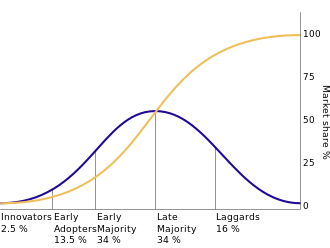
See what a word's worth.
Contact Us
WordsWorth Site Navigation
Measure Your Success: The Diffusion of Innovations
by Derek LeBlond
Version 6 - Create Date: 2022-06-15, Last Update: 2022-08-26
The Diffusion of Innovations is a powerful measure of success for product managers. You can also apply it in other areas. Let's take a moment to understand what it is, how to use it, and how to apply it in areas other than product management.
What is it?
The Diffusion of Innovations theory breaks a group in segments to measure the penetration of an invention over time. Professor Everett Rogers is given credit for the theory's popularity given its publication in his 1962 book, Diffusion of Innovations. The image that follows shows how the Diffusion of Innovations appears on a chart.

In the image, there are 5 group segments that align with the Bell Curve. A sigmoid function represents invention saturation across the group. The segments and their definitions are:
- Innovators - At 2.5% of the population, Innovators want to be first. They like to try and learn new things.
- Early Adopters - At 13.5% of the population, Early Adopters require little persuasion to come on board and tend to evangelize the invention.
- Early Majority - At 34% of the population, the Early Majority are followers who adopt an invention thanks to the evangelism of Early Adopters.
- Late Majority - At 34% of the population, the Late Majority are skeptics that use a wait-and-see approach to new inventions.
- Laggards - At 16% of the population, this group will not adopt an invention without extra effort and severe limits to the return on investment.
How do you use it?
First, you can use this to report to your investors or leadership. For product management, the group is customers and the invention is the product. The goal is 100% market share (saturation). To get the Diffusion of Innovations value, divide the number of customers you have by the number of customers in your market. That percentage dictates where you land in the curve, where the percentages total from left to right. For example, you have an Early Majority at 30% market share.
Second, where you are on the Diffusion of Innovations can dictate strategy. Only have innovators? Market yourself to some early adopters that may blog, report, or review your product. Have Early Adopters? Support their evangelism to access your Early Majority? Have an Early Majority? Start to engage the more classic marketing mechanisms. Have a Late Majority? Find a new market! You really don't want to invest the sunk costs that are the Laggards. Besides, you are a rock star at 84% market share.
How else can you use it?
The applications are truly infinite given it measures an invention. You can invent ideas, things, places, and more.
For example, you can use this to guide process adoption. Say you want to change how people do things on your team. This can help guide your success and strategy as you look to get your team's adoption. Find your innovators to help you iron out the idea. Get your Early Adopters to evangelize the new process, and so on. On a team of 10, you also know that 1 or 2 will need lots of extra time and attention for the change (our Laggards).
Another example would be to use this to guide strategy on vaccination rates. If 60% of the population has a vaccination, you have a Late Majority. That could be your clue that the remainder will take some very heavy marketing to reach and engage. Moreover, that last 16% will take some real coercion. In response, we saw some states engage in vaccine lotteries to reach these audiences.
In another example, it can measure the spread of a rumor. At least 50% will either be skeptical or not care, and about 16% will spread it to that Early Majority in the middle.
Conclusion
In short, the Diffusion of Innovations is a practical rule-of-thumb you can use to communicate to investors, leadership, and stakeholders of your progress. It is a powerful tool in the Product Management toolkit, as well as has the flexibility for innovative applications. Use it on your products or other things to help drive strategy, as well as make things a little less ambiguous for yourself and others.
Tags
Minutes to Read
3:20
Flesch Reading Ease
37
Difficult to read.